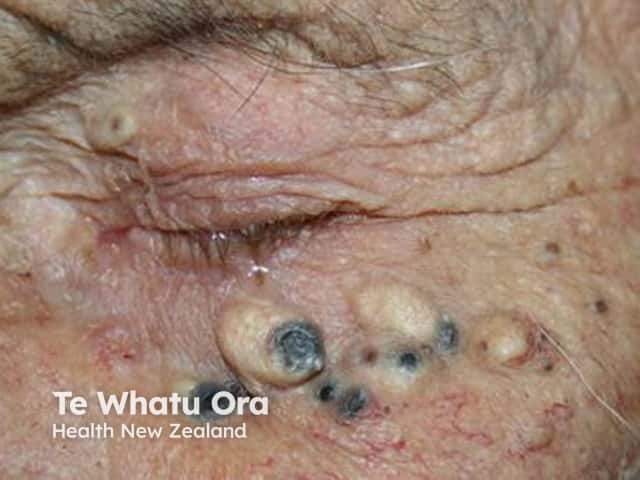Main menu
Common skin conditions

NEWS
Join DermNet PRO
Read more
Quick links
Last Reviewed: January, 2024
Authors: Dr Amanda Oakley, Dermatologist, Waikato Hospital, New Zealand (1999); review and minor update by Dr James A. Ida, MD, Dermatologist, Veterans Administration, USA (2024)
Reviewing dermatologist: Dr Ian Coulson
Edited by the DermNet content department
A solar or senile comedo (plural comedones) is a small skin-coloured papule found on the face of middle-aged or older individuals. Solar comedones tend to affect actinically damaged areas that have been exposed to sunlight over long periods of time.
The comedones may be open (‘blackheads’) or closed (‘whiteheads’) and are usually not inflamed.
Solar comedones are not related to comedones found in acne vulgaris.

Solar comedones

Solar comedones, mostly of the closed type

Solar comedones of the open type: the upper cheek is a typical site
Solar comedones and larger pseudocysts occur in association with solar elastosis, which causes yellowish, leathery skin and deep furrows. This combination of findings is also known as Favre-Racouchot syndrome and tends to affect the skin around the eyes, the temples, and the lateral neck. Favre-Racouchot syndrome is thought to be due to a combination of sun exposure and heavy smoking.
Deep linear furrows on the posterior neck due to solar elastosis, called cutis rhomboidalis nuchae, may also accompany Favré-Racouchot.

Cutis rhomboidalis nuchae often seen in association with Favre Racouchot syndrome

Solar comedones on the nose

Solar comedones

Solar comedones

Image from Dr S Janjua

Image from Dr S Janjua
Comedones may also be removed by electrocautery or laser ablation. However, they may recur and require further treatment from time to time.